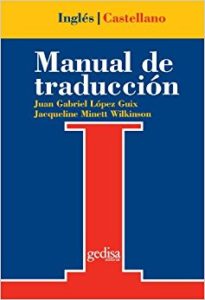Book review: Manual de traducción inglés-castellano
 Translation Handbook – Spanish book review
Translation Handbook – Spanish book review
Alert! This is a book review on a book written in Spanish. Therefore, the quotes will be in Spanish!
I’ve been having weekly discussions with people who want to become better translators. Some would call this “translation training.” As they ask questions, they drive me to read books. One of the gems I have encountered in my research is the Manual de traducción inglés-castellano by Juan Gabriel López Guix and Jacqueline Minett Wilkinson, published in 2014 by Editorial Edisa, in Barcelona, Spain.
The book covers many important subjects before getting into the practicalities of translation:
- The role of translators
- Language philosophy
- What is meaning?
- The differences between English and Spanish
- Translation theory from many points of view (at least 10 theorists are discussed in depth)
After covering this background information, it gets into practical issues:
- Text analysis
- Translation techniques and processes
- Reference material for translation
In a way, this seems extremely different from many presentations I have attended, where the goal appears to be to get to the point as quickly as possible so we can get the tips to be a good translator and become great in about an hour. The authors of the Manual de traducción understand that translation happens in a context, and first, we must know what we are doing. On page 18, it says, “lo que los lectores tienen en sus manos es un libro escrito por el traductor” (what readers hold in their hands is a book written by the translator.)
This statement is key. Translators are writers. The statement that follows is equally important: “Una obra está sujeta a múltiples interpretaciones en la medida en que varían los lectores o el contexto en que se lee.” (A work is subject to multiple interpretations based on who reads it and the context in which it is read.) Therefore, a translator must read carefully. The way we read will make a huge difference in our translation. We must hone our deep reading skills so we can become very accurate readers, since we are the last reader of the source text before the readers of the translation receive our translated text. What a tremendous responsibility!
Reading and writing. Understanding and expressing. This leads to the next issue in our role: Decision making.
“El proceso de traducción es un proceso de toma de decisiones, con distintas interpretaciones del texto de partida y diversas posibilidades de expresión en el texto de llegada.” (p. 19) (The translation process is a decision-making process, with different interpretations of the source text and different ways to convey the message in the target text.)
The book continues with one of the best comparisons of English and Spanish I have seen, introduces us to a variety of translation theories, and starts to get to the nuts and bolts of translation on page 193. That is where the explanation of text analysis begins. “Cuando el texto llega al traductor, él hace una lectura que condicionará a todas las demás.” (p. 193) (When the translator reads the text, his reading will influence further readings.) It proceeds to list a number of issues translators should consider:
- The setting in which the communication happens
- Actors in the process of communication and their relationship
- The role of the text in the act of communication
In chapter 9 we are given a series of techniques for translation, with their challenges and appropriate uses.
I encourage you to read the book for yourselves. There is so much to be gained from a thorough understanding of the foundational understanding of the theoretical underpinning of our work, besides the obvious list of techniques! Listing them here would probably lead to misunderstandings, since several techniques must be “handled with care.”
I read the whole book and wrote a 13-page summary for my own use, which I refer to constantly. There is simply no waste in this book! This is a must-read for those who want to hone their skills in English-Spanish translation.


Please, I would like to receive information about how to become a great translator Spanish English…